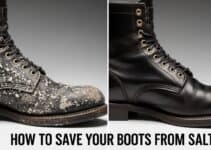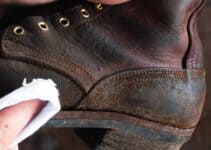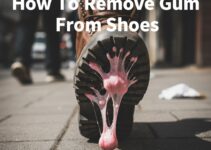Investing in quality work boots is one of the most practical decisions you can make, but when you see a $90 pair next to a $250 pair, it’s fair to ask: are the expensive ones truly worth the money?
As your knowledgeable friend who has spent time looking at what really goes into these things, here is the brutally honest breakdown. The short answer is yes, they usually are better, but you have to know what you’re paying for—and sometimes, you are just paying for a fancy name.
Remember the old saying: Never cheat yourself out of two things in life—shoes and a mattress. You spend two-thirds of your life on them. A wise old body man once told a new kid, “They don’t make plastic feet!” so you better take care of the ones you have with good boots.








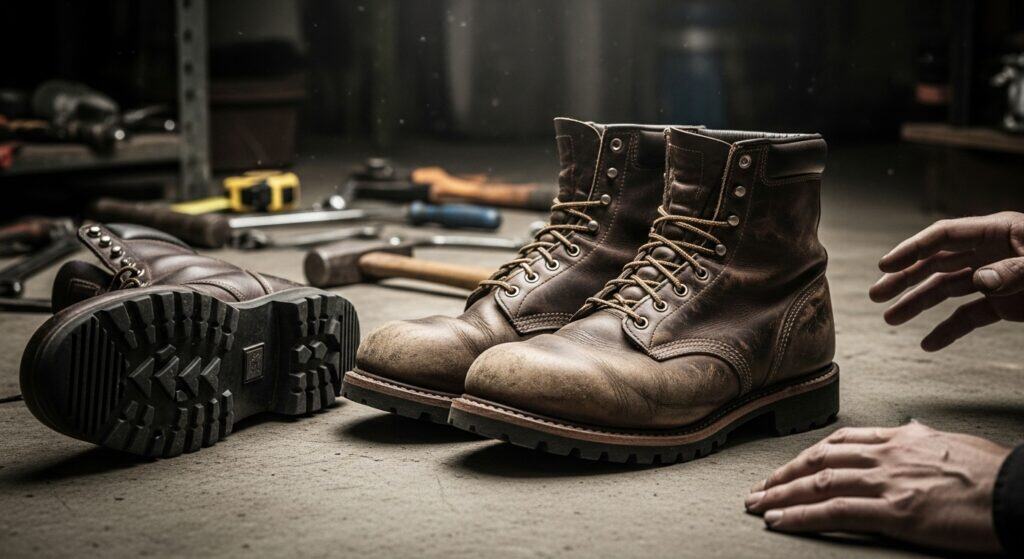
work boots
The 30-Second Verdict: When is Expensive “Worth It”?
Here’s the quick-answer checklist for when spending the extra cash is a smart decision:
It is 100% WORTH IT if:
- You work 40+ hours per week on your feet.
- You stand on hard surfaces like concrete all day.
- You experience foot, knee, or back pain after work.
- You work in heavy-duty, high-abuse environments (like construction, welding, or logging).
- You want a boot that can be repaired (resoled) instead of being tossed in the trash.
It is NOT WORTH IT if:
- You’re a weekend DIY-er and only need boots for about 10 hours a month.
- Your job is light-duty (such as driving or light warehouse tasks) and you prioritize a lightweight feel over extreme durability.
- You’re an apprentice on a tight budget who just needs to meet a basic safety code for 6–12 months.
The Anatomy of Price: What You Actually Pay For
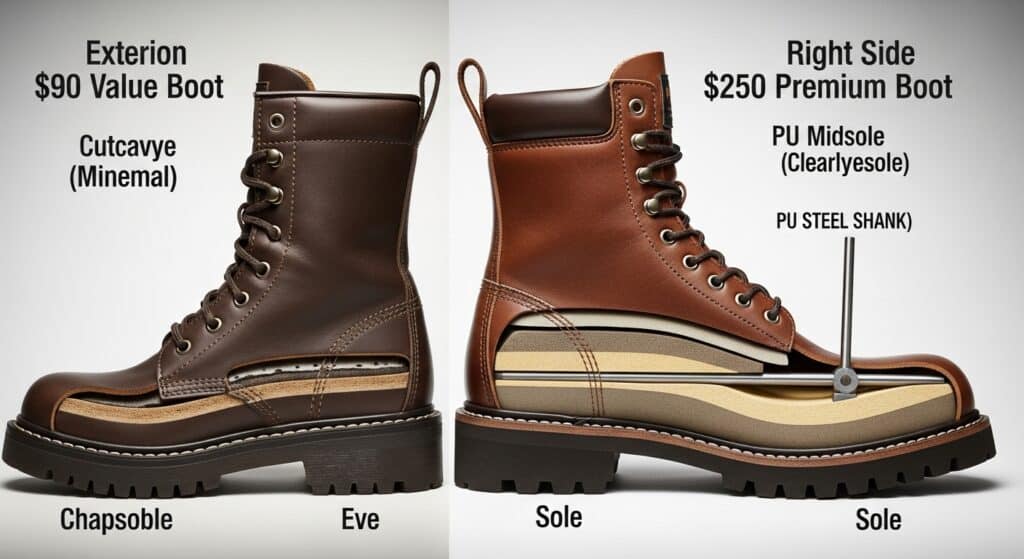
cheap vs expensive work boots
When we break open boots (or, in this case, look at the expert breakdowns), the premium cost boils down to five key variables that determine the boot’s quality.
| Feature | The $90 “Value” Boot | The $250 “Premium” Boot | Why It Matters (The Honest Truth) |
|---|---|---|---|
| Construction (The Frame) | Cemented (Glued) | Goodyear Welt, Stitchdown, or Blake Stitch | Cement construction is quick, cheap, and means you can’t resole the boot—it’s disposable. Goodyear welt is stitched, offering durability and making it far easier to replace the sole multiple times, potentially tripling the boot’s lifespan. |
| Midsole (The Shock Absorber) | EVA Foam | Polyurethane (PU) | This is huge for your knees and back. EVA is light and soft, but it “packs out” (flattens) in 3–6 months, leaving you standing on a hard, unforgiving platform. PU is denser, heavier, and resists compression, providing true, long-lasting shock absorption for years. |
| Insole/Footbed | Flimsy foam or fiberboard | Thick, vegetable-tanned leather or OrthoLite®/Anti-Fatigue (PU) | Cheap footbeds are often rubber on fiberboard (which is basically paper) and will crack with moisture. Premium leather footbeds are breathable and mold to the unique shape of your foot over time. |
| Leather Quality | “Genuine Leather” (corrected grain or splits) | Premium Full-Grain or Oil-Tanned Leather | Full-grain leather is the toughest and most durable part of the hide, resisting water and abrasion better. “Genuine leather” is often the lowest-quality hide. When buying expensive boots, look for the name of the tannery, rather than just “full grain”. |
| Internal Lining | Synthetic lining | Leather lining or nothing (unlined) | Cheap synthetic lining tends to rip easily in high-stress areas like the heel and toe. Leather linings are soft and luxurious, while unlined boots breathe better and mold better to your foot. |
When to SPLURGE vs. When to SAVE: A Guide for Your Job
Different jobs require different boots. Here’s a practical guide based on your daily grind:
When to SPLURGE (Invest in a Premium $200+ Boot)
- You’re on Concrete All Day (Mechanic, Factory, Warehouse Worker): Your biggest enemy is chronic fatigue. You must invest in a boot with a PU Midsole and a supportive insole because the cheap EVA foam in budget boots will be completely dead in about three months.
- You’re in Heavy Trades (Welder, Ironworker, Logger): Your enemy is abuse. You need Goodyear Welt Construction and Premium Full-Grain Leather because cheap, glued soles will be torn apart by rebar, slag, or mud. Premium boots can be rebuilt—brands like White’s, Wesco, Nicks, and JK Boots are known for this.
- You Have Foot, Knee, or Back Pain: Your enemy is poor support. You need a boot with a strong shank, a structured insole, and a stable platform. The ergonomic design and cushioning technologies in expensive boots reduce strain and fatigue.
When to SAVE (A $100 Boot is Fine)
- You’re a Weekend DIY-er or do Light Yard Work: You don’t need 2,000-hour durability for a 20-hour job. A cemented boot will serve you fine.
- Your Job Destroys Boots Anyway (Chemicals, Slurry): If you work in harsh chemicals, concrete slurry, or waste, these environments can dissolve even the best boots. In this case, it might be smarter to “buy cheap and buy often” (e.g., two $100 pairs per year) than to watch one $250 pair dissolve in eight months.
How to Spot a “Rip-Off” (Paying for a Name, Not Tech)

are expensive work boots worth it
Not every expensive boot is a quality boot; sometimes, you’re paying for clout or a designer label. Here’s how to avoid buying a $200 boot that’s built like a $90 boot:
Red Flag 1: Cement (Glued) Construction + High Price
If a boot is over $200 and isn’t Goodyear Welted, Stitchdown, or another skillful method, you’re often paying for the logo, not the build quality or the repairability. Many brands also fake or suggest Goodyear welts by gluing on imitation welts and stitching.
Red Flag 2: Basic EVA Midsole
If you press your thumb into the midsole and it feels squishy and light like a running shoe, that’s EVA. If you are paying premium prices, you should be getting the durable, heavier-feeling PU that resists compression.
Red Flag 3: Synthetic Interior Lining
If the inside of the boot is lined with synthetic fabric, it’s prone to ripping in high-stress areas. Expensive, traditional boots should be lined with leather or be unlined entirely.
Red Flag 4: Bad Customer Support
Cheaper brands often give you “bye-bye support” once they’ve sold the boot. Expensive, heritage brands tend to stand behind their products with service and warranties.
Frequently Asked Questions (FAQ)
How long should a good pair of work boots last?
If you wear boots 40+ hours a week, a cheap, cemented boot will typically last 6 to 12 months before the cushioning is dead or the sole fails. A high-quality, Goodyear-welted boot ($250+) should last 2 to 5 years, and can potentially last 10+ years with proper care and regular resoling. For example, J.K. Boots Superduty is designed to be repaired and resoled rather than replaced.
Is a Goodyear Welt always better than Cemented?
No, not always. While Goodyear welt is superior in durability and longevity, cemented boots are often much lighter and more flexible right out of the box. For a warehouse picker walking constantly on a flat floor, a lightweight, cemented boot is often more comfortable than a heavy, stiff welted boot.
Are $300+ boots (like Nicks or White’s) really worth it?
These are often “heritage” or “buy it for life” tools. You are paying for top-tier materials and a construction (like stitchdown or Goodyear welt) that is 100% rebuildable. If you are a professional who commits to conditioning and resoling them, the long-term cost is often lower than buying a new $150 boot every year.
Conclusion: The Real Cost of a “Cheap” Boot
A $90 boot isn’t cheaper; it’s a subscription. You buy one this year, one next year, and one the year after that. That’s $270 in three years, and your feet will likely hurt the entire time.
A $250 premium boot is a one-time investment that, with a little care, can last 3–5+ years, or even longer if you get it resoled. Stop buying disposable boots. You’re not just paying for a brand name; you’re paying for the PU midsoles, the quality construction, and the protective technology that your body deserves.
Splurge vs. Save: The TL;DR
| Your Job Type | Our Recommendation |
|---|---|
| Heavy-Duty Trades / Concrete | SPLURGE. You need PU midsoles and a welted construction for durability and support. |
| Light-Duty / Warehouse / DIY | SAVE. A lighter, cemented boot is fine and will be more comfortable and flexible. |
| Harsh Chemical / Slurry Sites | SAVE. Buy cheaper boots and replace them often. Harsh chemicals destroy all boots. |






